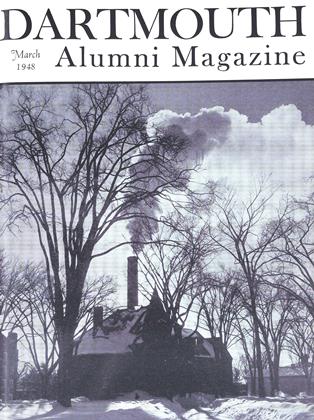STATISTICS ON THE make-up and accomplishments of the freshman class are compiled and carefully studied every year, but because of the unusually stiff competition for admission to the Class of 1951, whose 652 members were picked from an application list of more than 6,000, the statistics this year are being followed with special interest. In general, the results come up to expectations and reflect the higher standards set by the men themselves.
On the basis of the scholastic aptitude tests given, the Class of 1951 is well ahead of the previous six Dartmouth freshman classes and even further ahead of a large national group of first-year students enrolled at recognized colleges and universities. The top half of the present class did as well as the top 35% of the six previous Dartmouth classes and as well as the top 18% of the national group mentioned. The first real check on the use of these aptitudes will arrive with the posting and analysis of first-semester grades.
The relative standing of Dartmouth sons in the Class of 1951 is also being watched with special interest, since the preferred status which they were accorded under the Selective Process of Admission meant the acceptance of a substantial number of marginal men who might be expected to have some difficulty meeting the stiffer academic pace set by the class as a whole. In the entire group of 137 alumni sons, 26% received mid-term warnings for D's or E's in three subjects, a proportion 60% higher than that for the class as a whole. These statistics on scholastic difficulty probably confirm the marginal character of a substantial number of the Dartmouth sons admitted and, beyond that, may raise the important question of whether the preferred status given to such sons is not being carried somewhat too far by the College in its desire to give the sons of Dartmouth alumni the benefit of every doubt.
That the entering classes at Dartmouth are almost back to their normal all-civilian character is shown by the fact that of the 652 men in the Class of 1951, only 13% are former servicemen, very few of whom were in combat. The average entering age was also close to the prewar norm, being 18½ The veterans who matriculated last October averaged 21 years, 4 months; the civilians 18 years, 2 months. The youngest man in the class was just under 17, the oldest just under 30 with a wife and three children.
That the present freshman class rounds out its outstanding scholastic ability with leadership in athletics and other extracurricular activities is shown by these figures: 100 freshmen were class presidents; 37 were student council presidents; 30 were editors of student publications; 218 played varsity football, 31 as captains, and 130 played basketball; 114 were varsity trackmen; and 83 in all were varsity team captains. The men were drawn from 372 different schools, 56% of which were public high schools.
The competition for admission to Dartmouth in the Class of 1952 will be at least as stiff as that for the exceptional freshman class now enrolled, it is indicated by the number of active applications on file as of February 1. Somewhat to its surprise, the Admissions Office on that date was running nearly 800 ahead of last year's record number of applications. The applications from Dartmouth sons hoping to be members of '52 already number 247.
REVISED ARCHITECT'S DRAWING OF THE FRONT OF THE HOPKINS CENTER, embodying changes proposed by the advisory building committee, headed by prof Russell R. Lrmon'19 The new plans provide more room in the front of the building and a view of the campus from the first-floor alumn, lounge.
 View Full Issue
View Full Issue
More From This Issue
-
 Article
ArticleWORLD GOVERNMENT
March 1948 By THOMAS K. FIN LETTER -
 Article
ArticleA HANOVER DIARY
March 1948 By PROF. LEON BURR RICHARDSON '00 -
 Class Notes
Class Notes1918
March 1948 By ERNEST H. EARLEY, DONALD L. BARR, DAVID L. GARRATT -
 Article
Article"Suicide" Is Not for Cowards
March 1948 By JOHN HURD '21 -
 Class Notes
Class Notes1919
March 1948 By J. K. HUNTINGTON, MAX A. NORTON, ROSCOE A. HAYES -
 Article
ArticleThe Undergraduate Chair
March 1948 By John P. Stearns '49
Article
-
 Article
ArticleAlumni in Who's Who
March 1939 -
 Article
ArticleMore Writers
September 1980 -
 Article
Article1889*
May 1939 By DR. DAVID N. BLAKELY -
 Article
ArticlePRINCETON 13, DARTMOUTH 7
January 1951 By Francis E. Merrill '26 -
 Article
ArticleMetropolitan Notes
December 1938 By Milburn McCarty Jr. '35. -
 Article
ArticleNorth of Boston
March 1952 By Parker Merro '25


